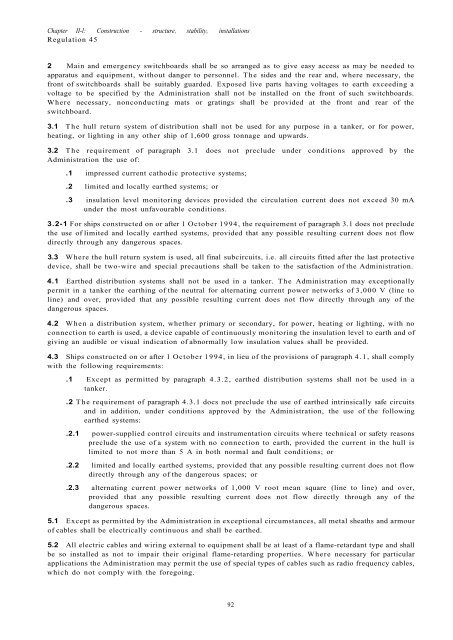Solas Consolidated Edition 2009.pdf
Solas Consolidated Edition 2009 for maritime
Solas Consolidated Edition 2009 for maritime
You also want an ePaper? Increase the reach of your titles
YUMPU automatically turns print PDFs into web optimized ePapers that Google loves.
Chapter II-l: Construction - structure, stability, installations<br />
Regulation 45<br />
2 Main and emergency switchboards shall be so arranged as to give easy access as may be needed to<br />
apparatus and equipment, without danger to personnel. The sides and the rear and, where necessary, the<br />
front of switchboards shall be suitably guarded. Exposed live parts having voltages to earth exceeding a<br />
voltage to be specified by the Administration shall not be installed on the front of such switchboards.<br />
Where necessary, nonconducting mats or gratings shall be provided at the front and rear of the<br />
switchboard.<br />
3.1 The hull return system of distribution shall not be used for any purpose in a tanker, or for power,<br />
heating, or lighting in any other ship of 1,600 gross tonnage and upwards.<br />
3.2 The requirement of paragraph 3.1 does not preclude under conditions approved by the<br />
Administration the use of:<br />
.1 impressed current cathodic protective systems;<br />
.2 limited and locally earthed systems; or<br />
.3 insulation level monitoring devices provided the circulation current does not exceed 30 mA<br />
under the most unfavourable conditions.<br />
3.2-1 For ships constructed on or after 1 October 1994, the requirement of paragraph 3.1 does not preclude<br />
the use of limited and locally earthed systems, provided that any possible resulting current does not flow<br />
directly through any dangerous spaces.<br />
3.3 Where the hull return system is used, all final subcircuits, i.e. all circuits fitted after the last protective<br />
device, shall be two-wire and special precautions shall be taken to the satisfaction of the Administration.<br />
4.1 Earthed distribution systems shall not be used in a tanker. The Administration may exceptionally<br />
permit in a tanker the earthing of the neutral for alternating current power networks of 3,000 V (line to<br />
line) and over, provided that any possible resulting current does not flow directly through any of the<br />
dangerous spaces.<br />
4.2 When a distribution system, whether primary or secondary, for power, heating or lighting, with no<br />
connection to earth is used, a device capable of continuously monitoring the insulation level to earth and of<br />
giving an audible or visual indication of abnormally low insulation values shall be provided.<br />
4.3 Ships constructed on or after 1 October 1994, in lieu of the provisions of paragraph 4.1, shall comply<br />
with the following requirements:<br />
.1 Except as permitted by paragraph 4.3.2, earthed distribution systems shall not be used in a<br />
tanker.<br />
.2 The requirement of paragraph 4.3.1 docs not preclude the use of earthed intrinsically safe circuits<br />
and in addition, under conditions approved by the Administration, the use of the following<br />
earthed systems:<br />
.2.1 power-supplied control circuits and instrumentation circuits where technical or safety reasons<br />
preclude the use of a system with no connection to earth, provided the current in the hull is<br />
limited to not more than 5 A in both normal and fault conditions; or<br />
.2.2 limited and locally earthed systems, provided that any possible resulting current does not flow<br />
directly through any of the dangerous spaces; or<br />
.2.3 alternating current power networks of 1,000 V root mean square (line to line) and over,<br />
provided that any possible resulting current does not flow directly through any of the<br />
dangerous spaces.<br />
5.1 Except as permitted by the Administration in exceptional circumstances, all metal sheaths and armour<br />
of cables shall be electrically continuous and shall be earthed.<br />
5.2 All electric cables and wiring external to equipment shall be at least of a flame-retardant type and shall<br />
be so installed as not to impair their original flame-retarding properties. Where necessary for particular<br />
applications the Administration may permit the use of special types of cables such as radio frequency cables,<br />
which do not comply with the foregoing.<br />
92


